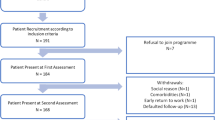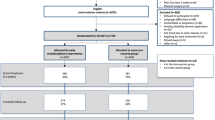Abstract
Low-back pain is a major health and socio economic problem. Functional restoration programs (FRP) have been developed to promote the socio-professional reintegration of patients with important work absenteeism. The aim of this study was to determine the long-term effectiveness of FRP in a group of 105 chronic low-back pain patients and to determine the predictive factors of return to work. One hundred-and-five chronic LBP patients with over 1 month of work absenteeism were included in a FRP. Pain, professional status, quality of life, functional disability, psychological impact, and fear and avoidance beliefs were evaluated at baseline, after 1 year and at the end of follow-up. Main effectiveness criterion was return to work. Fifty-five percent of the patients returned to work after mean follow-up time of 3.5 years, compared with 9% of the patients at work at baseline. Quality of life, functional disability, psychological factors, and fear and avoidance beliefs were all significantly improved. Three predictive factors were found: younger age at the onset of low-back pain, practice of sports, and shorter duration of sick leave at baseline. FRP show positive results in terms of return to work for chronic LBP patients with prolonged work absenteeism. Efforts should be made to propose such programs at an earlier stage of the disease.





Similar content being viewed by others
References
Andersson GB (1999) Epidemiological features of chronic low-back pain. Lancet 354(9178):581–585
Waddell G (1993) Simple low back pain: rest or active exercise? Ann Rheum Dis 52(5):317–319
Frymoyer JW (1988) Back pain and sciatica. N Engl J Med 318(5):291–300
Spitzer (1987) Scientific approach to the assessment and management of activity-related spinal disorders: a monograph for clinicians. Report of the Quebec task force on spinal disorders. Spine 12:S1–S59
Bigos SJ et al (2009) High-quality controlled trials on preventing episodes of back problems: systematic literature review in working-age adults. Spine J 9(2):147–168
Henchoz Y, Kai-Lik So A (2008) Exercise and nonspecific low back pain: a literature review. Joint Bone Spine 75(5):533–539
Poiraudeau S, Rannou F, Revel M (2007) Functional restoration programs for low back pain: a systematic review. Ann Readapt Med Phys 50(6):419–424, 425–429
Burke SA, Harms-Constas CK, Aden PS (1994) Return to work/work retention outcomes of a functional restoration program. A multi-center, prospective study with a comparison group. Spine 19(17):1880–1885 (discussion 1886)
Chou R, Huffman LH (2007) Nonpharmacologic therapies for acute and chronic low back pain: a review of the evidence for an American Pain Society/American College of Physicians clinical practice guideline. Ann Intern Med 147(7):492–504
Genet F, Poiraudeau S, Revel M (2002) Effectiveness and compliance to a center-based short rehabilitation program with a home-based program for chronic low back pain. Ann Readapt Med Phys 45(6):265–272
Bontoux L et al (2004) Prospective study of the outcome at one year of patients with chronic low back pain in a program of intensive functional restoration and ergonomic intervention factors predicting their return to work. Ann Readapt Med Phys 47(8):563–572
Jousset N et al (2004) Effects of functional restoration versus 3 hours per week physical therapy: a randomized controlled study. Spine 29(5):487–493 (discussion 494)
Wands K et al (1990) A questionnaire investigation of anxiety and depression in early dementia. J Am Geriatr Soc 38(5):535–538
Bjelland I et al (2002) The validity of the Hospital Anxiety and Depression Scale. An updated literature review. J Psychosom Res 52(2):69–77
Chaory K et al (2004) Validation of the French version of the fear avoidance belief questionnaire. Spine 29(8):908–913
Marty M et al (1998) Validation of the French version of the Dallas Pain Questionnaire in chronic low back pain patients. Rev Rhum Engl Ed 65(2):126–134
Yvanes-Thomas M et al (2002) Validity of the French-language version of the Quebec back pain disability scale in low back pain patients in France. Joint Bone Spine 69(4):397–405
Merritt JL et al (1986) Measurement of trunk flexibility in normal subjects: reproducibility of three clinical methods. Mayo Clin Proc 61(3):192–197
Biering-Sorensen F (1984) Physical measurements as risk indicators for low-back trouble over a one-year period. Spine (Phila Pa 1976) 9(2):106–119
Shirado O et al (1995) Concentric and eccentric strength of trunk muscles: influence of test postures on strength and characteristics of patients with chronic low-back pain. Arch Phys Med Rehabil 76(7):604–611
Elfering A (2006) Work-related outcome assessment instruments. Eur Spine J 15(Suppl 1):S32–S43
Verfaille S et al (2005) Evaluation after four years of exercise therapy for chronic low back pain. Ann Readapt Med Phys 48(2):53–60
Bendix AE et al (1998) A prospective, randomized 5-year follow-up study of functional restoration in chronic low back pain patients. Eur Spine J 7(2):111–119
Hazard RG et al (1989) Functional restoration with behavioral support. A one-year prospective study of patients with chronic low-back pain. Spine 14(2):157–161
Alaranta H et al (1994) Intensive physical and psychosocial training program for patients with chronic low back pain. A controlled clinical trial. Spine 19(12):1339–1349
Hlobil H et al (2005) The effects of a graded activity intervention for low back pain in occupational health on sick leave, functional status and pain: 12-month results of a randomized controlled trial. J Occup Rehabil 15(4):569–580
Indahl A, Velund L, Reikeraas O (1995) Good prognosis for low back pain when left untampered. A randomized clinical trial. Spine (Phila Pa 1976) 20(4):473–477
Indahl A et al (1998) Five-year follow-up study of a controlled clinical trial using light mobilization and an informative approach to low back pain. Spine (Phila Pa 1976) 23(23):2625–2630
Lindstrom I et al (1992) The effect of graded activity on patients with subacute low back pain: a randomized prospective clinical study with an operant-conditioning behavioral approach. Phys Ther 72(4):279–290 (discussion 291–293)
Loisel P (1997) A population-based, randomized clinical trial on back pain management. Spine (Phila Pa 1976) 22(24):2911–2918
Andersson GB, Svensson HO, Oden A (1983) The intensity of work recovery in low back pain. Spine 8(8):880–884
Taimela S et al (2000) The role of physical exercise and inactivity in pain recurrence and absenteeism from work after active outpatient rehabilitation for recurrent or chronic low back pain: a follow-up study. Spine 25(14):1809–1816
Author information
Authors and Affiliations
Corresponding author
Rights and permissions
About this article
Cite this article
Poulain, C., Kernéis, S., Rozenberg, S. et al. Long-term return to work after a functional restoration program for chronic low-back pain patients: a prospective study. Eur Spine J 19, 1153–1161 (2010). https://doi.org/10.1007/s00586-010-1361-6
Received:
Revised:
Accepted:
Published:
Issue Date:
DOI: https://doi.org/10.1007/s00586-010-1361-6




